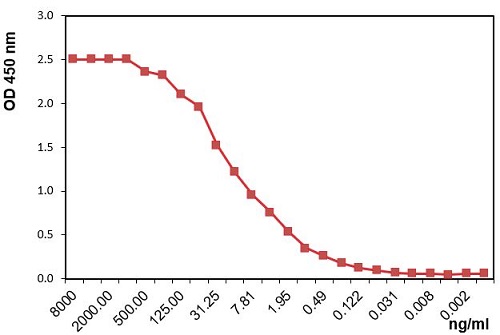RANKL, Soluble (human) (rec.)
| Code | Size | Price |
|---|
| AG-40B-0008-C010 | 10 ug | £170.00 |
Quantity:
| AG-40B-0008-3010 | 3 x 10 ug | £330.00 |
Quantity:
Prices exclude any Taxes / VAT
Overview
Antibody Clonality: Enzyme
Regulatory Status: RUO
Target Species:
- Human
- Mouse
Shipping:
Blue Ice
Storage:
-20°C
Images
Documents
Further Information
Alternate Names/Synonyms:
TRANCE; ODF; OPGL; TNFSF11; CD254
Concentration:
0.1mg/ml after reconstitution.
EClass:
32160000
Endotoxin:
<0.01EU/µg purified protein (LAL test; Lonza).
Form (Short):
liquid
Formulation:
Lyophilized. Contains PBS.
Handling Advice:
After reconstitution, prepare aliquots and store at -20°C.Avoid freeze/thaw cycles.Centrifuge lyophilized vial before opening and reconstitution.PBS containing at least 0.1% BSA should be used for further dilutions.
Long Description:
Protein. Human RANKL (aa 152-317) is fused at the N-terminus to a FLAG®-tag. Source: HEK 293 cells. Endotoxin content: <0.01EU/µg purified protein (LAL test; Lonza). Lyophilized. Contains PBS. Binds to human and mouse RANK. Purity: >95% (SDS-PAGE). RANKL is an osteoclast differentiation and activation factor. Augments the ability of dendritic cells to stimulate naive T cell proliferation. Important regulator of interactions between T cells and dendritic cells and may play a role in the regulation of the T cell-dependent immune response. RANKL plays an important role in the progression of breast cancer.
Molecular Weight:
~28kDa (SDS-PAGE)
NCBI, Uniprot Number:
O14788
Package Type:
Plastic Vial
Product Description:
RANKL is an osteoclast differentiation and activation factor. Augments the ability of dendritic cells to stimulate naive T cell proliferation. Important regulator of interactions between T cells and dendritic cells and may play a role in the regulation of the T cell-dependent immune response. RANKL plays an important role in the progression of breast cancer.
Purity:
>95% (SDS-PAGE)
Sequence:
Human RANKL (aa 152-317) is fused at the N-terminus to a FLAG®-tag.
Source / Host:
HEK 293 cells
Specificity:
Binds to human and mouse RANK.
TAGs:
FLAG
Transportation:
Non-hazardous
UNSPSC Category:
Other Proteins
UNSPSC Number:
12352202
Use & Stability:
Stable for at least 6 months after receipt when stored at -20°C. Working aliquots are stable for up to 3 months when stored at -20°C.
References
Receptor activator of NF-kappaB and osteoprotegerin expression by human microvascular endothelial cells, regulation by inflammatory cytokines, and role in human osteoclastogenesis: P. Collin-Osdoby, et al.; J. Biol. Chem. 276, 20659 (2001) | Functional expression of receptor activator of nuclear factor kappaB in Hodgkin disease cell lines: P. Fiumara, et al.; Blood 98, 2784 (2001) | Suppression of IL-12 Production by Soluble CD40 Ligand: Evidence for Involvement of the p44/42 Mitogen-Activated Protein Kinase Pathway: M. Wittmann, et al.; J. Immunol. 168, 3793 (2002) | Induction of Cell Cycle Arrest and Apoptosis by the Proteasome Inhibitor PS-341 in Hodgkin Disease Cell Lines Is Independent of Inhibitor of Nuclear Factor-kappaB Mutations or Activation of the CD30, CD40, and RANK Receptors: B. Zheng, et al.; Clin. Cancer Res. 10, 3207 (2004) | Osteoprotegerin production by human intestinal epithelial cells: a potential regulator of mucosal immune responses: K. Vidal, et al.; Am. J. Physiol. Gastrointest. Liver Physiol. 287, G836 (2004) | A novel in vivo role for osteoprotegerin ligand in activation of monocyte effector function and inflammatory response: D. Seshasayee, et al.; J. Biol. Chem. 279, 30202 (2004) | Mechanisms of spontaneous osteoclastogenesis in cancer with bone involvement: I. Roato, et al.; FASEB J. 19, 228 (2005) | Icariin inhibits the osteoclast formation induced by RANKL and macrophage-colony stimulating factor in mouse bone marrow culture: K.M. Chen, et al.; Pharmazie 62, 388 (2007) | Receptor Activator of Nuclear Factor Kappa B Ligand (RANKL) Modulates the Expression of Genes Involved in Apoptosis and Cell Cycle in Human Osteoclasts: E. Rimondi, et al.; Anatom. Rec. 290, 838 (2007) | Evaluating the Bone Tissue Regeneration Capability of the Chinese Herbal Decoction Danggui Buxue Tang from a Molecular Biology Perspective: W.-L. Wang, et al.; Biomed. Res. Int. 2014, 853234 (2014)



